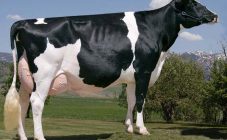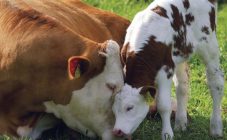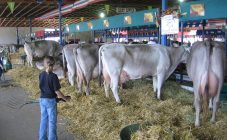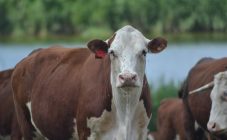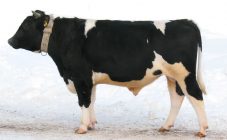Content:
It is believed that if a cow has a strong skeleton and large size, then it can only be bred for meat, such animals give little milk. But there are several exceptions, first of all, this is the Kostroma breed of cows. It is special because it has a meat and dairy direction. It is rightfully considered the pride of the Soviet selection. Such cows are ideal for growing in the central part of the Russian Federation and areas similar in climate.
From the history
The first attempts to breed and create Kostroma cows began in 1919. In those days, the country's leadership adhered to the principles of maximalism. It presented breeders with the daunting task of getting a large beef cow, while still delivering good milk production.
Initially, two directions took part in the development: the Miskaya and Babayevskaya branches. But the results were unsatisfactory. Then the Swiss and then the Alguz breeds were added to these branches.
By the 40s, all the same experiments gave results. It turned out to bring out a strong, fleshy, kneeling animal, which at the same time gave a lot of milk. The new breed was registered in 1944, its clear description and characteristics appeared.
To date, work is underway on three main branches:
- Strongman KTSK 84;
- KTSK 83 salad;
- Karo KTSK 101.
The considered breed of cows is dominant on farms in central Russia, but the main nursery remained in the Kostroma region. Ivanovskaya and Vladimirskaya regions, as well as the Republic of Mari-El, showed good results in cultivation.
Specifications
The Kostroma cow has its own distinctive features, including external and productivity.
Appearance
There are special visual characteristics of the Kostroma breed of cows that are unique to these animals:
- sturdy construction;
- massive physique;
- a slightly stretched body with an abundance of muscles;
- elongated head;
- deep developed chest;
- straight back;
- raised withers;
- short legs;
- well-developed chest;
- voluminous wide udder in the shape of a bowl.
Performance and character
Cows of this breed are very friendly and easily live in the herd. Surprisingly, in farms, females gain up to 800 kg, while in a private courtyard, the weight does not exceed 600 kg. The picture is the same for the bulls in terms of weight gain. In a herd, a bull quickly reaches 1.3 tons, in a private farm, its weight is no more than 900 kg.
The Kostroma breed includes 14 lines, each of which has its own characteristics for milk and meat. On average, one head can get up to 5000 liters of milk per year with an approximate fat content of 3.9%.
The average profitability from breeding cows of this breed is about 65%, when raising bulls this figure reaches 80%.
Care rules
When growing the Kostroma breed, you should know the features of this particular variety in order to achieve the best results and performance.
Power features
When organizing food for cattle of this variety, some characteristics of the animals should be taken into account:
- food for a dry animal should be abundant and consist of 20 kg of juicy dry food (for example, clover hay) and 6 kg of concentrated food;
- if the cow is milking, then the food is chosen in accordance with the needs and preferences of the animal itself;
- if the food is distributed correctly, then the cow will fully repay with large volumes of milk;
- for the development of young heifers, their growth should be constantly monitored in order to choose the right diet and amount of food.
To raise gobies for meat, in the first year of life, they should be provided with a balanced nutritious menu, which should include:
- concentrated feed;
- return;
- whole milk.
As a top dressing when growing young cattle, you can use hay tea, boiled vegetables, jelly, acidophilus. In summer, everything is much simpler - for full growth, livestock must graze in the fields, receiving natural natural nutrition in the form of green grass.
If you properly organize food and create comfortable living conditions for animals, then as a result you can get large volumes of milk and meat.
Conditions of detention
Premises for keeping cows of the Kostroma breed should be equipped, clean and well-ventilated. This will help you get the best performance.
Feeders and drinkers should be installed in the cow stall, and water should be available to the animal at all times. It is best to provide a special chute in the cow's habitat, which will ensure the automatic flow of manure and urine. If it is intended to use a litter that will be replaced, then raise the floor by about half a meter.
It is important to take care of the windows in the barn to provide light for the cows during the winter, but they should be at a sufficient height that the cow cannot reach.
The barn ceiling is best made of wood and double. An insulating layer is placed between the boards.
Breed advantages and disadvantages
In essence, the Kostroma cows are very hardy animals. Their strong, powerful body structure is ready not only for harsh climatic conditions, but also for a change in diet.
Very good growth rates are a big plus: they gain weight well, give excellent healthy offspring.
Nevertheless, the main advantage is the simultaneous meat and dairy orientation. It is this breed that has a huge number of record holders for maximum milk yield. Their performance is much higher than the average.
Almost until the very frost, the Kostroma breed of cows can be under an open shed. They tolerate cold periods well.
Animals of the presented breed are long-lived. With proper care, the period of active operation reaches up to 22 years.
The Kostroma breed also has one significant drawback - it is the irregular shape of the udder, due to which the milk flow rate is very low - 1.2 kg / min.
Another disadvantage of the representatives of the Kostroma variety is poor heat tolerance.The Kostroma cow is not suitable for growing in the steppe and hot countries.
Tips & Tricks
For many years now, Russian farmers and not only have been raising cows of this breed. They have their own secrets and tricks that help to achieve certain goals when growing the Kostroma breed:
- All conditions of maintenance and care very strongly affect milk yield and weight gain of cattle.
As practice shows, when the temperature in the barn decreases, the fat content of milk increases, but the volume of milk yield decreases. If the temperature rises, then the volume of milk increases, but the fat content decreases again.
- Another factor that can affect productivity is the regrouping of individuals. It is important that the cows walk in the same herd.
- Also, the volume of milk production can be affected by the daily routine, or rather non-compliance.
- A too large herd can also reduce milk volume.
- Milk yield may decrease if it is too noisy near the place of detention. In a calm, quiet atmosphere, cows feel better and have more productivity.
- Individuals of the Kostroma breed are prone to hierarchical building of connections in the herd, therefore it is recommended to form it from animals of the same age.
- Animals do not like to change places of pastures.
As you can see, thanks to the presence of such cattle breeds as Kostroma, you can buy an animal that shows good performance, both in the meat and dairy direction. Due to the fact that they were bred for the central part of Russia, caring for them will not be difficult, since the animals will be able to endure all the features of the climate of this territory.



